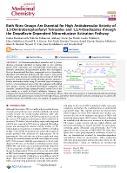Both Nitro Groups Are Essential for High Antitubercular Activity of 3,5-Dinitrobenzylsulfanyl Tetrazoles and 1,3,4-Oxadiazoles through the Deazaflavin-Dependent Nitroreductase Activation Pathway

Autor
Fabiánová, Viktória
Vocat, Anthony
Dušek, Jan
Valášková, Lenka
Stolaříková, Jiřina
Kitson, Russell R. A.
Djaout, Kamel
Mikušová, Katarína
Baulard, Alain R.
Cole, Stewart T.
Korduláková, Jana
Datum vydání
2024Publikováno v
Journal of Medicinal ChemistryRočník / Číslo vydání
67 (1)ISBN / ISSN
ISSN: 0022-2623ISBN / ISSN
eISSN: 1520-4804Metadata
Zobrazit celý záznamTato publikace má vydavatelskou verzi s DOI 10.1021/acs.jmedchem.3c00925
Abstrakt
3,5-Dinitrobenzylsulfanyl tetrazoles and 1,3,4-oxadiazoles, previously identified as having high in vitro activities against both replicating and nonreplicating mycobacteria and favorable cytotoxicity and genotoxicity profiles were investigated. First we demonstrated that these compounds act in a deazaflavin-dependent nitroreduction pathway and thus require a nitro group for their activity. Second, we confirmed the necessity of both nitro groups for antimycobacterial activity through extensive structure-activity relationship studies using 32 structural types of analogues, each in a five-membered series. Only the analogues with shifted nitro groups, namely, 2,5-dinitrobenzylsulfanyl oxadiazoles and tetrazoles, maintained high antimycobacterial activity but in this case mainly as a result of DprE1 inhibition. However, these analogues also showed increased toxicity to the mammalian cell line. Thus, both nitro groups in 3,5-dinitrobenzylsulfanyl-containing antimycobacterial agents remain essential for their high efficacy, and further efforts should be directed at finding ways to address the possible toxicity and solubility issues, for example, by targeted delivery.
Klíčová slova
Animals, Antitubercular Agents, Mammals, Microbial Sensitivity Tests, Mycobacterium tuberculosis, Nitroreductases, Oxadiazoles, Structure-Activity Relationship, Tetrazoles
Trvalý odkaz
https://hdl.handle.net/20.500.14178/2175Licence
Licence pro užití plného textu výsledku: Creative Commons Uveďte původ 4.0 International







